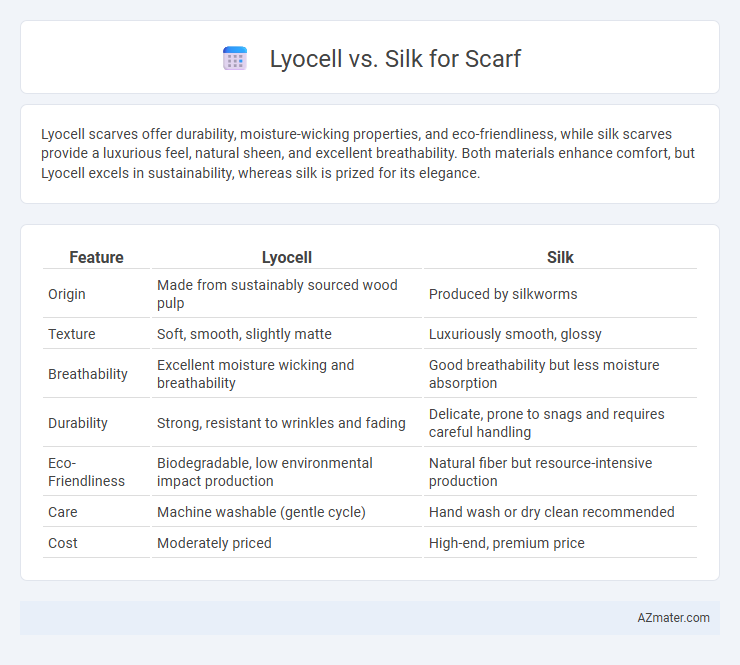Lyocell scarves offer durability, moisture-wicking properties, and eco-friendliness, while silk scarves provide a luxurious feel, natural sheen, and excellent breathability. Both materials enhance comfort, but Lyocell excels in sustainability, whereas silk is prized for its elegance.
Table of Comparison
| Feature | Lyocell | Silk |
|---|---|---|
| Origin | Made from sustainably sourced wood pulp | Produced by silkworms |
| Texture | Soft, smooth, slightly matte | Luxuriously smooth, glossy |
| Breathability | Excellent moisture wicking and breathability | Good breathability but less moisture absorption |
| Durability | Strong, resistant to wrinkles and fading | Delicate, prone to snags and requires careful handling |
| Eco-Friendliness | Biodegradable, low environmental impact production | Natural fiber but resource-intensive production |
| Care | Machine washable (gentle cycle) | Hand wash or dry clean recommended |
| Cost | Moderately priced | High-end, premium price |
Introduction to Lyocell and Silk Scarves
Lyocell scarves, crafted from sustainable wood pulp fibers, offer exceptional breathability, moisture-wicking properties, and a smooth, soft texture suitable for sensitive skin. Silk scarves, made from natural protein fibers produced by silkworms, are prized for their luxurious sheen, lightweight feel, and excellent drape enhancing elegance. Both materials provide distinct advantages in comfort, durability, and aesthetics, catering to diverse style preferences and ethical considerations.
Origin and Production Processes
Lyocell is a sustainable fabric derived from wood pulp, primarily sourced from eucalyptus trees, using a closed-loop production process that recycles water and solvents, minimizing environmental impact. Silk is a natural protein fiber obtained from the cocoons of silkworms, requiring labor-intensive sericulture and delicate harvesting methods to preserve the fine filaments. While lyocell manufacturing emphasizes eco-friendly technology, silk production centers on traditional animal-based cultivation.
Environmental Impact Comparison
Lyocell and silk differ significantly in environmental impact, with Lyocell being a more sustainable option due to its production from sustainably sourced wood pulp and a closed-loop manufacturing process that recycles water and solvents, minimizing waste. Silk production involves sericulture, which requires mulberry cultivation and large water use, and often impacts biodiversity due to habitat alteration and chemical inputs. Choosing Lyocell reduces carbon footprint and water usage compared to silk, making it preferable for eco-conscious consumers seeking environmentally friendly scarves.
Texture and Feel: Comfort Analysis
Lyocell scarves offer a smooth, breathable texture that feels cool and soft against the skin, making them highly comfortable for all-day wear. Silk scarves provide a luxurious, natural sheen with a lightweight, slippery feel that drapes elegantly but may not be as breathable as Lyocell. Both materials ensure comfort, yet Lyocell excels in moisture-wicking and temperature regulation, ideal for sensitive skin and warmer climates.
Durability and Longevity
Lyocell scarves offer superior durability due to their strong, moisture-wicking fibers resistant to wear and tear, making them ideal for everyday use. Silk scarves, while luxurious and soft, are more delicate and prone to damage from abrasion, sunlight, and washing, requiring careful handling to maintain longevity. Choosing Lyocell results in a longer-lasting scarf with less maintenance, while silk prioritizes elegance but sacrifices durability.
Breathability and Moisture Management
Lyocell scarves offer superior breathability due to their microfibril structure that promotes air circulation and moisture wicking, making them ideal for maintaining comfort in warm conditions. Silk scarves provide a smooth, lightweight feel but are less effective at moisture management, as silk tends to retain humidity and dries slower than Lyocell. Choosing Lyocell enhances moisture absorption and evaporative cooling, resulting in a scarf that stays dry and comfortable throughout the day.
Care and Maintenance Requirements
Lyocell scarves require gentle hand washing or machine washing on a delicate cycle with mild detergent to maintain fabric integrity and avoid shrinking. Silk scarves demand more delicate care, including hand washing with cold water and specialized silk detergent or dry cleaning to preserve the fiber's natural sheen and prevent damage. Both fibers benefit from air drying away from direct sunlight and careful storage to prevent wrinkles and fabric deterioration.
Style Versatility and Appearance
Lyocell scarves offer a matte finish with a soft drape, providing a modern, understated elegance that complements casual and professional outfits alike. Silk scarves shine with a natural sheen and vibrant color depth, enhancing formal ensembles and classic styles with their luxurious appearance. Both fibers excel in versatility, but silk's lustrous texture delivers a timeless aesthetic, whereas lyocell appeals to those seeking a sustainable yet stylish alternative.
Cost Differences: Lyocell vs Silk
Lyocell scarves generally cost less than silk due to more affordable raw materials and sustainable manufacturing processes, making them a budget-friendly option for eco-conscious consumers. Silk scarves, derived from silkworm cocoons, incur higher costs reflecting expensive cultivation, harvesting, and labor-intensive production methods. This price disparity often positions lyocell as a practical alternative without sacrificing softness and drape quality, while silk remains a luxury choice valued for its natural sheen and exquisite texture.
Which is Better for Scarves? Final Verdict
Lyocell offers superior moisture-wicking and breathability compared to silk, making it ideal for all-season scarves that combine comfort and durability. Silk provides a luxurious sheen and softness with natural temperature regulation, but requires delicate care and is less resistant to wear. For scarves balancing practicality and elegance, lyocell is better suited for everyday use, while silk remains the choice for occasional luxury and formal accessories.

Infographic: Lyocell vs Silk for Scarf
 azmater.com
azmater.com